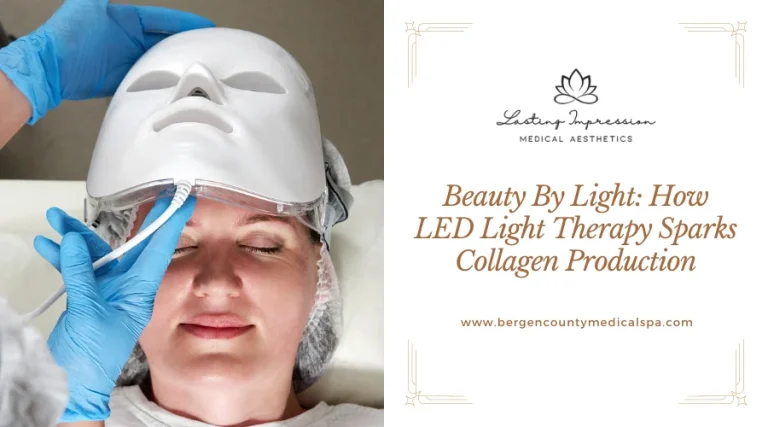In the quest for timeless beauty, individuals often explore various skincare treatments and technologies. One such innovative and non-invasive method gaining popularity is LED light therapy. Originally developed by NASA for plant growth experiments in space, LED light therapy has found its way into skincare clinics and beauty routines, offering a myriad of benefits, including the promotion of collagen production.
Why is Collagen Important?
Want the secret to maintaining youthful, resilient skin – collagen. This structural protein is the unsung hero responsible for the elasticity and firmness that characterize a youthful complexion. As we journey through the years, however, the production of collagen undergoes a natural decline, leaving our skin susceptible to the inevitable signs of aging: fine lines, wrinkles, and sagging.
To complicate matters, environmental foes like UV radiation and pollution only hasten the breakdown of this precious protein. In this blog, we delve into the essence of collagen, its vital role in skin health, and the factors that contribute to its decline.
Collagen is a fibrous protein found abundantly in the skin, making up a significant portion of its structure. Its role is nothing short of essential – providing the framework that supports the skin’s strength, suppleness, and overall vitality. Think of collagen as the scaffolding that keeps our skin taut and smooth.
How Collagen Declines
As the calendar pages turn, our bodies undergo a natural aging process that impacts the production of collagen. In our youth, collagen synthesis is robust, contributing to the plumpness and radiance of our skin. However, as we age, the production of collagen gradually diminishes. This decline is a major contributor to the development of fine lines and wrinkles, as well as a loss of skin firmness.
While aging is an inevitable part of life, external factors can exacerbate the decline of collagen. One of the chief culprits is prolonged exposure to UV radiation from the sun.
UV rays penetrate the skin, triggering the breakdown of collagen fibers and accelerating the aging process. Similarly, pollution introduces harmful free radicals to the skin, further contributing to collagen degradation and premature aging.
Preserving Collagen: A Holistic Approach
Understanding the intricacies of collagen and its relationship with aging empowers us to take proactive steps in preserving this vital protein. Adopting a holistic approach to skincare involves both internal and external factors.
- Balanced Nutrition – A diet rich in vitamins, minerals, and antioxidants supports collagen synthesis. Include foods like fruits, vegetables, and lean proteins to provide your skin with the nutrients it needs to maintain its elasticity.
- Hydration – Adequate hydration is essential for skin health. Water helps maintain the skin’s moisture balance, preventing it from becoming dry and prone to premature aging.
- Sun Protection – Shield your skin from harmful UV rays by using sunscreen daily. This simple yet effective measure goes a long way in preserving collagen and preventing sun-induced damage.
- Skincare Products – Choose skin care products that stimulate collagen production. Ingredients like retinoids, peptides, and vitamin C are known to support collagen synthesis and improve skin texture.
Collagen is the backbone of youthful skin, and understanding its dynamics is key to preserving a vibrant complexion as we age. By adopting a comprehensive approach to skincare that addresses both internal and external factors, we can actively contribute to maintaining optimal collagen levels and enjoying skin that radiates with health and vitality. Embrace the journey of aging with grace, armed with the knowledge of collagen as your ally in the pursuit of timeless beauty.
How LED Light Therapy Works
LED light therapy involves the use of specific wavelengths of light to stimulate cellular activity in the skin. Different colors of light penetrate the skin at varying depths, triggering various biological responses. When it comes to collagen production, red and near-infrared lights are the stars of the show.
- Red Light (630-700nm) – Red light, with wavelengths between 630 and 700 nanometers, is known for its ability to penetrate the skin at a deeper level. This light stimulates the mitochondria in skin cells, enhancing their energy production. The increased energy, in turn, boosts cellular metabolism and prompts fibroblasts—cells responsible for collagen production—to kick into high gear.
- Near-Infrared Light (700-1200nm) – Near-infrared light, with wavelengths ranging from 700 to 1200 nanometers, penetrates even deeper into the skin. It promotes circulation, reduces inflammation, and supports the healing process. Additionally, near-infrared light further energizes the cells, encouraging optimal collagen synthesis.
Collagen Benefits of LED Light Therapy
In the ever-evolving landscape of skincare, a revolutionary technology is making waves and changing the way we approach anti-aging routines – LED light therapy. This non-invasive and safe treatment has become a beacon of hope for those seeking healthier and more youthful skin.
- Increased Collagen Production – LED light therapy has been shown to stimulate fibroblasts, leading to an increase in collagen synthesis. This boost in collagen helps improve skin texture, reduce fine lines, and promote a more youthful appearance.
- Improved Skin Elasticity – As collagen levels rise, so does the skin’s elasticity. LED light therapy aids in restoring and maintaining the skin’s firmness, reducing sagging and promoting a smoother complexion.
- Reduced Wrinkles and Fine Lines – Regular sessions of LED light therapy have been linked to a reduction in the appearance of wrinkles and fine lines. By addressing collagen production, this treatment helps minimize the signs of aging.
- Enhanced Healing and Repair – The near-infrared light component of LED therapy not only stimulates collagen synthesis but also accelerates the skin’s natural healing processes. This can be particularly beneficial for individuals recovering from various skin concerns or procedures.
As the beauty industry continues to witness advancements in technology, LED light therapy stands at the forefront, offering a powerful solution to enhance skin health and beauty. In this blog post, we’ll explore the transformative effects of LED light therapy, its role in collagen production, and the exciting possibilities that lie ahead.
Current Impact & Future Prospects
LED light therapy has garnered widespread acclaim for its efficacy and safety. Its non-invasive nature makes it an appealing option for individuals seeking a gentle yet effective solution for skin rejuvenation. As technology continues to advance, we can anticipate further research and developments in LED light therapy, unlocking new possibilities for enhancing skin health and beauty.
- Advancements in Wavelengths – Ongoing research is exploring the effects of different light wavelengths on collagen synthesis. As we delve deeper into the intricacies of light therapy, we may discover specific wavelengths that target collagen more precisely, providing even more tailored solutions for diverse skincare needs.
- Integration with Other Technologies – Combining LED light therapy with other cutting-edge technologies holds the promise of amplified results. Researchers are exploring synergies between LED therapy and complementary treatments to create comprehensive skincare regimens that address multiple concerns simultaneously.
Incorporating LED light therapy into your beauty routine is a step towards unlocking the full potential of your skin’s vitality. As this technology continues to evolve, so does the promise of achieving healthier, more youthful skin. Illuminate your beauty routine with the transformative power of LED light therapy, and let your skin radiate with newfound vitality. The future of skincare is bright, and LED light therapy is leading the way towards a radiant revolution in the pursuit of timeless beauty.






